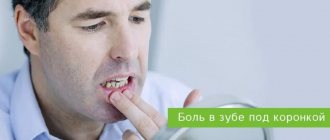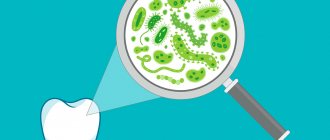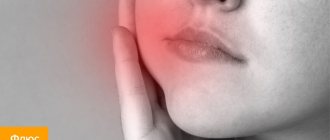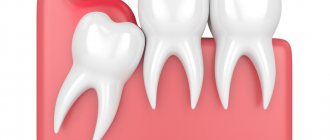Author of the article:
Soldatova Lyudmila Nikolaevna
Candidate of Medical Sciences, Professor of the Department of Clinical Dentistry of the St. Petersburg Medical and Social Institute, Chief Physician of the Alfa-Dent Dental Clinic, St. Petersburg
Expecting relief from pain from going to the dentist, patients sometimes leave the office confused - why hasn’t the pain completely gone away? It can be present for several hours or last much longer.
Questions and answers on: tooth hurts under a filling
The most common questions patients ask after tooth filling concern pain.
- Question : “A month ago, I had a tooth healed using paste to kill the nerve and installing a temporary filling, but it hurts when pressed. Also, the gums on the cheek side were swollen. After the temporary filling fell out, I did not install a new one. What to do? Is it related to the root or the nerves?” Answer : “Most likely, the periosteum became inflamed because the canals were not treated in time. It was necessary to treat them and put a permanent filling. In your case, the tooth needs to be removed, but if you consult a doctor urgently, there is a small chance of saving it.”
- Question : “Can a tooth hurt after filling? It’s been 2 hours since the filling was placed, but I feel a little pain.” Answer : “Mild pain in a filled tooth is a natural physiological reaction to surgical intervention in the dental cavity. Periodic painful sensations may be felt for 2 months until complete healing. They will pass unless the pain becomes more severe and increasing.”
- Question : “Yesterday we got a filling, but the tooth still hurts. A small rash and itching appeared near him. I can’t stand it any longer, what should I do?” Answer : “You need to see a doctor to replace the filling. You have developed an allergic reaction to it. This is quite a rare occurrence."
- Question : “A week ago I was treated for caries and a filling was placed at the 6th unit below. But the tooth did not stop hurting. It especially bothers me at night; I can’t sleep due to the throbbing pain. Should a tooth hurt after filling?” Answer : “Most likely, the dentist treated you for deep caries due to periodontitis or chronic pulpitis and made a mistake, guided only by a visual examination of the oral cavity. In any case, it was necessary to take an x-ray of the tooth affected by caries. We urgently need to remove the filling and treat the canals.”
- Question : “2 weeks ago a permanent filling was placed without removing the nerve, but it still hurts me to chew. In addition, the tooth reacts to cold and hot food and at times there is aching pain.” Answer : “Such symptoms may indicate the development of chronic pulpitis or the development of an abscess inside the tooth.”
If various pains appear in the tooth after the filling procedure, then the only recommendation is to contact a qualified specialist. After all, the reasons can be completely different.
How to get rid of gum pain?
Unpleasant sensations in the gums in the first hours after dental treatment are normal. A good doctor will always warn the patient about such things after a dental procedure.
However, a distinction must be made between some discomfort and pain that is difficult to bear. Discomfort is characterized by unpleasant sensations, tingling, and sometimes slight pain in the treatment area during the first two days. The opposite is a state of unbearable pain, the inability to eat, rolling and throbbing pain. In this case, the patient cannot function normally: work or fall asleep.
Causes of pain after dental treatment
- Individual patient reaction to an anesthetic injection. Gums and soft tissues react differently to the action of the injected drug;
- Rejection of the installed filling. Soft tissues “do not accept” the filling installed by the doctor, signaling this with pain;
How to relieve gum pain at home
In any case, the patient is unlikely to be able to function normally, since the pain tends to increase: it becomes more frequent and more difficult for the person to bear. Therefore, it is better to visit the doctor again as soon as possible. If for some reason it is impossible to do this, then try to reduce the pain yourself.
- Try not to eat foods at high or excessively low temperatures. This will only aggravate the situation, since in the first time after treatment the gums are sensitive to external irritants;
- Brush your teeth only with a cool brush. There is a misconception that a warm toothbrush helps reduce gum pain. In fact, this will only increase the sensitivity of already inflamed tissues;
- Do not apply mechanical force to the gums. This applies to both the pressure applied when brushing your teeth and simple picking in your mouth out of curiosity. It is human nature to touch those places that hurt, so make sure that soft tissues are not touched by hands or other objects;
- Under no circumstances apply traditional painkillers or disinfectants to the gums - peppers, garlic, and so on.
- Rinse your mouth with a salt solution, a decoction of sage or chamomile. When rinsing, try to focus on the affected area. At the same time, do not forget that you should not abuse this procedure - rinse no more than three times a day;
- Crush one tablet of analgin and aspirin. Mix the resulting powder, pour it onto a cotton swab (or a cotton swab) and gently apply it to the inflamed area without pressing;
- If the pain is mild, then prepare the following solution: add 0.02 furatsilin to a full glass of water. Mix thoroughly and caress the inflamed area 3 times a day for 5 minutes.
Remember that these recommendations are intended to alleviate the patient’s condition and gain time to visit the doctor.
Therefore, even if you feel the pain easing, do not rush to refuse a visit to the clinic. After a short period of calm and cessation of home treatments, the pain may intensify again, so it is wiser to deal with the root cause of the inflammation in the doctor's office. You can find out more about the features of gum treatment among our services. MAKE AN APPOINTMENT
Gum pain in a child
Teeth growth
. In young children, unpleasant and painful sensations can be caused by teething. In this case, children constantly gnaw and bite objects, making it clear that they are “uneasy” in their mouth. If the cause of concern is teething, then make sure that the toys and special objects the child bites are treated with antiseptics to prevent infection. The best option would be to buy a special rubber “biting ring” for your child and treat it with an antiseptic.
Infection
. If a child experiences severe pain, he either cries or lets his parents know that he has pain “in the mouth.” This may be the cause of infection from constant bites of various objects. At home, you can temporarily use Nurofen or Viburkol. However, the best solution is to visit a doctor.
Tablets against pain in the gums:
- Analgin
. A common cheap pain reliever that is found in almost every first aid kit. Efficiency is average. - Nise.
This is a serious drug that specializes in muscle pain and post-traumatic consequences. - Ketanov
. The most effective drug against toothache. - Dexalgin
. A fast and long-lasting drug. - Baralgin
. An effective pain reliever. The effectiveness is average, since severe pain requires taking two tablets at a time. The patient is not recommended to exceed the norm of 6 tablets per day. - Nurofen.
In addition to relieving pain, it also directly affects the soft tissue of the gums. - Paracetamol. Used against pain, inflammation and fever. A cheap product that is in every first aid kit.
Why does the pain get worse at night?
Surely a person has noticed throughout his life that pain in the mouth (gums, teeth, throat) begins to worsen at night. More often a person notices this in two ways:
- Before sleep, there is an increase in pain.
- A man wakes up in the middle of the night in pain.
The peculiarity of such phenomena is that in the morning the unpleasant sensations subside. So what is the reason? The mystery lies in the nature of the process - inflammation. This process in the human body is regulated by the adrenal glands - glands near the left and right kidneys. In the evening and at night, the adrenal glands do not work, so the pain is felt more strongly. When morning comes, they are active again, which improves the person’s condition.
How to keep your gums healthy
As has already become clear, one of the causes of pain is the incorrect insertion of an artificial tooth or its rejection by soft tissues. But the fact is that it is wiser, in principle, not to bring the tooth to the point of removal or artificial replacement.
Firstly
, having natural healthy teeth is better than wearing artificial implants.
Secondly
, this will save the patient from possible pain and complications after the installation procedure, although it does not exclude the chance of pain in his own teeth.
Third
, if a patient receives an implant, this increases by half the chance that he will have another artificial tooth installed in the near future. The fact is that if the doctor finds one unhealthy tooth that needs to be removed, then there is a high probability that another similar one is “ripening” in the mouth, because this indicates the general level of oral hygiene of the patient.
Therefore, maintain oral hygiene: brush your teeth at least twice a day, select a suitable brush and toothpaste with the help of dentists, use rinses and dental floss. Also, remember to visit your dentist at least twice a year. Good luck!
We recommend you read it
What is the difference between periodontal disease and periodontitis?
How and how to relieve toothache at home
Pulpitis
Tooth hurts after nerve removal and filling
Only a dentist after an examination will help you figure out why a tooth hurts after removing a nerve and filling its canals. Treating teeth on your own without a diagnosis is highly discouraged.
In dental practice, the procedure for treating tooth canals by removing a nerve is a rather complex manipulation. Cases of medical error are common. They are fraught with various complications, in which the filled tooth continues to hurt.
The main reason why a “dead tooth” (without a nerve) is bothersome is:
- removal of the filling material beyond the apex of the tooth - this occurs due to incorrect definition
- working tooth length;
- the doctor filled the canal incorrectly;
- a tool broke off in the canal;
- root perforation of the tooth;
- If your tooth aches, you may be allergic to the filling material.
It is worth considering that a tooth under a filling can hurt even without a nerve. After all, during the extraction procedure, only a small part of it is removed from the root canal, which branches off from the main nerve trunk. In addition, when removing and filling canals, dental tissues are damaged. When an anesthetic is applied to a tooth, pain is not felt; it begins to be felt after the anesthesia wears off. Such painful sensations are called post-filling.
After removal of a nerve, neighboring teeth can often be bothered, but it seems as if it is the treated tooth that is hurting. An experienced doctor will examine the dentition to identify and eliminate this problem. However, it is worth sounding the alarm when the nerve has been removed for a long time, and the tooth continues to hurt - this symptom may signal the development of chronic pulpitis or periodontitis.
Sharp edges of the alveoli
Socket pain can be caused by protruding sharp edges of the socket, which injure the mucous membrane located above them. Pain appears 1-2 days after tooth extraction , when the edges of the gums above the socket begin to approach each other.
- The pain intensifies during chewing and when touching the gums;
- When you feel the hole with your finger, a protruding sharp edge of the bone is detected, and a sharp pain occurs.
This pain can be distinguished from the pain of alveolitis by the absence of inflammation in the socket area and the presence of an organizing blood clot in it.
Tooth hurts after root canal filling
Dental clinic patients are often concerned about the question of why their tooth hurts after inserting filling material into the tooth canal after removal of the nerve. Since any intervention in the body has its consequences, toothache is an “echo” of the filling procedure.
The most common reasons for a tooth to ache after root canal filling are:
- burns and overdrying of dentin;
- allergic reaction to filling material;
- depressurization of the seal;
- change in bite;
- exposure to polymerization lamps;
- shrinkage of the filling.
After the procedure, the dentist usually advises you on how long the tooth under the filling hurts. However, if you feel increasing pain in a filled tooth for more than 2 weeks, you should urgently consult a doctor. Such pain can occur when an instrument breaks off in the canal, root perforation, or improper treatment of pulpitis.
Memo for patients
- Do not delay visiting your doctor if there are signs of an allergic reaction.
- If the pain increases, swelling, redness, or fever appears, make an emergency appointment
- Do not relieve pain with antibiotics unless prescribed by a doctor.
- Do not use alcohol or garlic applications, as they can burn the mucous membrane.
- Never heat your tooth
- Follow all dentist recommendations
A qualified doctor, a clinic with modern digital equipment and following the recommendations will help you avoid situations where a tooth hurts after installing a filling.
Expert of the article Bolshakova Evgenia Vladimirovna Dentist-hygienist
More than 11 years of experience
Pain after pulpitis treatment
When treating pulpitis, the nerve is removed and the canals are cleaned. This is a complex procedure during which special instruments are inserted into the root canals, which can injure tissue near the apex of the root. When treating canals, powerful antiseptics are used, which sometimes irritate nearby tissues. Therefore, after the end of anesthesia, patients almost always feel pain of varying intensity.
When the canal filling procedure is carried out correctly, the pain goes away within 1-7 days, gradually subsiding until it disappears completely.
Pain after periodontitis treatment
The peculiarity of periodontitis is that it often develops asymptomatically, so the tooth may not bother you before treatment, and only after a visit to the dentist begins to hurt. The doctor is not at fault here; the pain that arises is explained by the complexity of the pathological process.
With periodontitis, pathogenic microorganisms move freely from the oral cavity to the root of the tooth, gradually accumulating in the bone tissue around it. After treatment, when the canals are filled, access to the tooth root for bacteria is blocked, the source of infection is localized, and the bacteria remaining in the bone tissue are neutralized by the body’s immune system. If the course of the disease is favorable, pain disappears within two months after treatment.
With weak immunity or other individual characteristics of the body, an inflammatory process occurs. Patients feel aching pain, throbbing, pain when biting and pressing on the tooth. If you experience complaints after periodontitis treatment, you should immediately see a doctor, as additional treatment may be needed.











